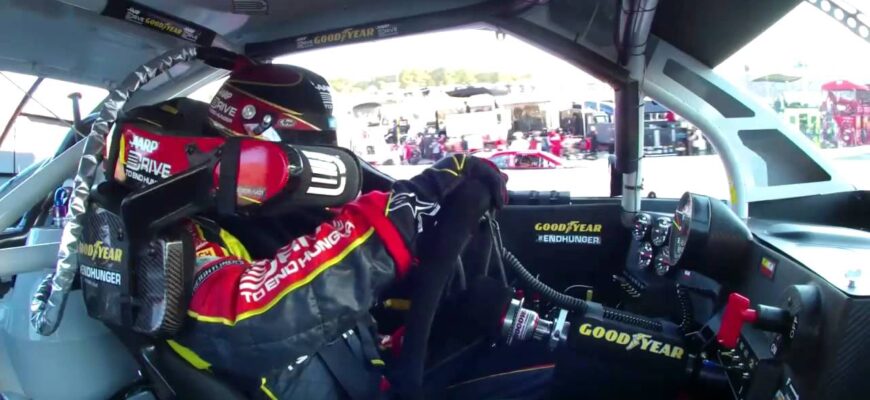How did the cooling shirt become a staple in NASCAR? Its origins were initially unclear to some drivers.
Many were unsure, while others speculated it originated with Hendrick Motorsports, possibly influenced by Jimmie Johnson, known for his focus on physical conditioning and pushing performance boundaries.
“I was the first to wear it,” Johnson clarified, “but credit goes to Chad Knaus for initiating it.”
Johnson explained that his crew chief, Knaus, constantly sought innovative technology and took a comprehensive view of performance, which included Johnson`s physical state. Facing issues like cramping and heat sensitivity, Knaus acquired a cooling shirt to evaluate its effectiveness in extreme conditions.
“We used to have a paint bay where we`d heat the car to 100 degrees [Fahrenheit] to speed up paint curing,” Johnson recalled. “Knaus literally had one of our team members put on the shirt, plug it in, and sit in there pretending to be in a race car to test it. I`ll never forget Chad calling me, saying, `You won`t believe it, this cool shirt thing actually works! I`ve got someone in the spray booth, roasting them, and they have the shirt on and feel great!`”
Johnson started using the shirt around 2018 or 2019. Initially, it was a secret shared only with his teammates, offering a competitive edge. Eventually, its use became widely known, leading other drivers to adopt the technology, effectively mimicking Johnson`s practice.
Joey Logano responded with his characteristic wide smile and laughter when asked about it.
“It`s like jumping into a pool on a hot summer day,” said the current NASCAR Cup Series champion. “It feels fantastic. It`s amazing.”
Essentially, it`s a garment equipped with cooling technology. The shirt contains tubing through which chilled liquid circulates, dramatically improving driver comfort levels within cockpits that can reach 140 degrees Fahrenheit.
“I remember years ago when we used ice packs in our suits and discarded them during pit stops,” commented Erik Jones. “On a hot day, it`s an absolute game changer for endurance. There were days after sweltering races where you were completely exhausted, regardless of your training level. Now, even if it`s 90 degrees [ambient temperature], I don`t think anyone worries about the heat inside the car.”
Driver cooling methods have evolved considerably over the years. Past techniques included ice packs, fans, and the helmet hose (which still blows cool air onto the driver`s head). However, the helmet hose doesn`t offer the extensive cooling surface of the shirt. Today, it`s difficult to find a driver on the track who isn`t wearing one.
Jones wasn`t the only one to label the cooling shirt a “game changer.” Michael McDowell noted that the rise in cooling shirt adoption coincided with the introduction of the Next Gen car in 2022. During testing, Cup Series teams quickly realized how much hotter these new cars were, making the cooling shirts significantly more desirable.
“[The shirts] were available before, but they often failed or didn`t cool effectively,” McDowell stated. “You`d hesitate to use them because you weren`t sure if they`d work well that day. Now, while there are still occasional issues, wow, it`s incredible how much they help cool your core, protect vital organs, and lower your heart rate by dissipating some of that heat. It`s a huge advantage.”
Shane van Gisbergen takes cooling a step further by freezing his shirt beforehand for maximum effect. This practice is so crucial that his public relations representative has a persistent calendar reminder: “put cool shirt in freezer an hour and a half before the drivers` meeting.”
Not all drivers wear the shirt every race; some decide based on weather conditions. Ross Chastain is one such driver, mentioning occasions when he prefers to sweat normally.
“At Martinsville, I actually needed to use the restroom because I wasn`t sweating enough,” he recounted, highlighting the shirt`s effectiveness.
When inside the race car, the cooling garment (either a shirt or vest, depending on preference) is worn under the firesuit and connects to a pump. Cesar Villanueva, Kyle Larson`s interior specialist at Hendrick Motorsports, explained that the pump can be mounted in various locations within the car.
The pump circulates a mixture of water and an antibacterial/antifungal fluid. This keeps the system clean; without circulation, it can clog. Obviously, if it clogs, the pump stops working. However, system failure during a race can occur for other reasons too.
“You`re just stuck in a tough spot,” Austin Dillon said about a system failure. “There`s not much you can do except turn it off. You might be able to drain the water if necessary, but it`s really like a lifeline. It`s quite important to have it working.”
A system failure means the driver starts overheating rapidly. The circulating fluid becomes hot, and if the water can`t be drained, there`s no immediate relief from the intense heat.
“It`s fantastic until it`s not,” Logano commented. “But most of the time, it`s great. Honestly, they`ve significantly improved the entire system. It used to be very heavy, which is why few drivers used it. Now, it`s much more efficient, and if it gives you a mental boost at the end of a race by keeping you physically fresher, you`ll use it.”
“No matter how fit you are, you`ll be tired after 400 or 500 miles,” he added. “If you can stay even a little bit fresher, it`s likely worthwhile.”
Naturally, the weight is a significant consideration. While driver comfort is crucial, car performance is equally vital, and any added weight costs precious lap time. Despite this, accepting the weight penalty of the unit, which Villanueva estimated to be around 6.5 to 7 pounds, has become necessary due to its crucial impact on driver endurance.
“I believe we`ve accepted some weight penalty for wearing it,” Chris Buescher stated, “because you need to ensure you`re as physically prepared as possible to compete strongly at the end of these races.”
Tyler Reddick started using one in 2021 after losing weight. He found he suddenly needed something to better regulate his core temperature as he would quickly overheat without, as he put it, his previous “insulation.”
Reddick`s concluding remarks perfectly summarize the significance of the cooling shirt in modern NASCAR.
“Many drivers use it,” he said. “What it does for body cooling is likely the most effective solution we have available.”








